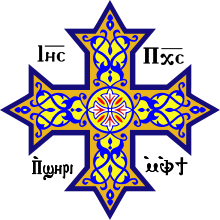Clement of Alexandria
Titus Flavius Clemens, also known as Clement of Alexandria (Greek: Κλήμης ὁ Ἀλεξανδρεύς; c. 150 – c. 215),[4] was a Christian theologian and philosopher who taught at the Catechetical School of Alexandria. A convert to Christianity, he was an educated man who was familiar with classical Greek philosophy and literature. As his three major works demonstrate, Clement was influenced by Hellenistic philosophy to a greater extent than any other Christian thinker of his time, and in particular by Plato and the Stoics.[5] His secret works, which exist only in fragments, suggest that he was also familiar with pre-Christian Jewish esotericism and Gnosticism. In one of his works he argued that Greek philosophy had its origin among non-Greeks, claiming that both Plato and Pythagoras were taught by Egyptian scholars.[6] Among his pupils were Origen and Alexander of Jerusalem.
Clement of Alexandria | |
|---|---|
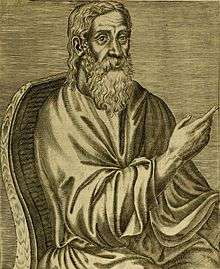 Clement from Les vrais pourtraits et vies des hommes illustres grecz, latins et payens (1584) by André Thévet | |
| Born | c. 150 |
| Died | c. 215 |
| Other names | Clement Alexandrine |
Notable work | Protrepticus Paedagogus Stromata |
| Era | Ancient philosophy Patristic Period |
| Region | Western Philosophy |
| School | Middle Platonism Alexandrian school |
| Institutions | Catechetical School of Alexandria |
| Notable students | Origen and Alexander |
Main interests | Christian theology |
Notable ideas |
|
Influences
| |
Influenced
| |
Saint Clement of Alexandria | |
|---|---|
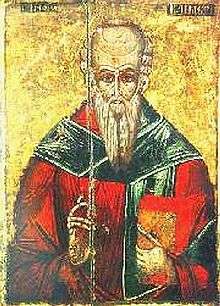 Icon of Clement of Alexandria | |
| Church Father, Theologian | |
| Venerated in | Oriental Orthodoxy Eastern Catholicism Anglican Communion |
| Canonized | Pre-congregation |
| Feast | 4 December (Eastern Catholicism, Anglicanism) 5 December (Episcopal Church, Anglicanism) |
| Controversy | Regarded as a heretic by Photius. |
Catholic cult suppressed | 1586 by Pope Sixtus V |
| Part of a series on |
| Catholic philosophy |
|---|
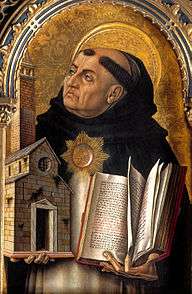   |
| Ethics |
|
| Schools |
|
| Philosophers |
|
Postclassical
|
|
Modern
|
|
Contemporary
|
|
|
Clement is usually regarded as a Church Father. He is venerated as a saint in Coptic Christianity, Eastern Catholicism, Ethiopian Christianity and Anglicanism. He was previously revered in Western Catholicism, but his name was removed from the Roman Martyrology in 1586 by Pope Sixtus V on the advice of Baronius.
Biography
Neither Clement's birthdate or birthplace is known with any degree of certainty. It is conjectured that he was born sometime around 150. According to Epiphanius Scholasticus, he was born in Athens, but there is also a tradition of an Alexandrian birth.[7][8]
His parents were pagans, and Clement was a convert to Christianity. In the Protrepticus he displays an extensive knowledge of Greek mythology and mystery religions, which could only have arisen from the practice of his family's religion.[7]
Having rejected paganism as a young man due to its perceived moral corruption, he travelled in Greece, Asia Minor, Palestine and Egypt. Clement's journeys were primarily a religious undertaking. In Greece, he encountered an Ionian theologian, who has been identified as Athenagoras of Athens; while in the east, he was taught by an Assyrian, sometimes identified with Tatian, and a Jew, who was possibly Theophilus of Caesarea.[9]
In around 180, Clement reached Alexandria,[10] where he met Pantaenus, who taught at the Catechetical School of Alexandria.[11] Eusebius suggests that Pantaenus was the head of the school, but it is controversial whether the institutions of the school were formalized in this way before the time of Origen.[12][13][note 1][15] Clement studied under Pantaenus, and was ordained to the priesthood by Pope Julian before 189. Otherwise, virtually nothing is known of Clement's life in Alexandria. He may have been married, a conjecture supported by his writings.[16]
During the Severian persecutions of 202–203, Clement left Alexandria. In 211, Alexander of Jerusalem wrote a letter commending him to the Church of Antioch,[17] which may imply that Clement was living in Cappadocia or Jerusalem at that time. The date and location of his death are unknown.
Theological works
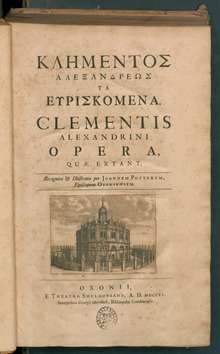
Trilogy
Three of Clement's major works have survived in full, and they are collectively referred to as the trilogy:[18]
Protrepticus
_-_Foto_G._Dall'Orto.jpg)
The Protrepticus is, as its title suggests, an exhortation to the pagans of Greece to adopt Christianity, and within it Clement demonstrates his extensive knowledge of pagan mythology and theology. It is chiefly important due to Clement's exposition of religion as an anthropological phenomenon.[20] After a short philosophical discussion, it opens with a history of Greek religion in seven stages.[21] Clement suggests that at first, men mistakenly believed the Sun, the Moon and other heavenly bodies to be gods. The next development was the worship of the products of agriculture, from which he contends the cults of Demeter and Dionysus arose.[22] Man then paid reverence to revenge, and deified human feelings of love and fear, among others. In the following stage, the poets Hesiod and Homer attempt to enumerate the Gods; Hesiod's Theogony giving the number of twelve. Finally, men proclaimed other men, such as Asclepius and Heracles, deities.[22] Discussing idolatry, Clement contends that the objects of primitive religion were unshaped wood and stone, and idols thus arose when such natural items were carved.[23] Following Plato, Clement is critical of all forms of visual art, suggesting that artworks are but illusions and "deadly toys".[23]
Clement criticizes Greek paganism in the Protrepticus on the basis that its deities are both false and poor moral examples, and he attacks the mystery religions for their obscurantism and trivial rituals.[23] In particular, the worshippers of Dionysus are ridiculed for their ritual use of children's toys.[24] He suggests at some points that the pagan deities are based on humans, but at others that they are misanthropic demons, and he cites several classical sources in support of this second hypothesis.[25] Clement, like many pre-Nicene fathers, writes favourably about Euhemerus and other rationalist philosophers, on the grounds that they at least saw the flaws in paganism. However, his greatest praise is reserved for Plato, whose apophatic views of God prefigure Christianity.[26]
The figure of Orpheus is prominent throughout the narrative, and Clement contrasts his song, representing pagan superstition, with the divine Logos of Christ.[27] According to Clement, through conversion to Christianity alone can man fully participate in the Logos, which is universal truth.[28]
Paedagogus

This work's title, translatable as "tutor", refers to Christ as the teacher of all mankind, and it features an extended metaphor of Christians as children.[29] It is not simply instructional : the author intends to show how the Christian should respond to the Love of God authentically.[30] Clement, following Plato (Republic 4:441), divides life into three elements: character, actions and passions. The first having been dealt with in the Protrepticus, he devotes the Paedagogus to reflections on Christ's role in teaching us to act morally and to control our passions.[31] Despite its explicitly Christian nature, Clement's work draws on Stoic philosophy and pagan literature; Homer alone is cited over sixty times in the work.[32]
Although Christ, like man, is made in the image of God, he alone shares the likeness of God the Father.[33] Christ is both sinless and apathetic, and thus by striving to imitate Christ, man can achieve salvation. To Clement, sin is involuntary, and thus irrational [αλόγον], removed only through the wisdom of the Logos.[34] God's guidance of us away from sin is thus a manifestation of God's universal love for mankind. The word play on λόγος and αλόγον is characteristic of Clement's writing, and may be rooted in the Epicurean belief that relationships between words are deeply reflective of relationships between the objects they signify.[35]
Clement argues for the equality of sexes, on the grounds that salvation is extended to all of mankind equally.[36] Unusually, he suggests that Christ is neither male or female, and that God the Father has both male and female aspects: the eucharist is described as milk from the breast (Christ) of the Father.[37][38] He is supportive of women playing an active role in the leadership of the church, and provides a list of women he considers inspirational, which includes both Biblical and Classical Greek figures. It has been suggested that Clement's progressive views on gender as set out in the Paedagogus were influenced by Gnosticism.[37] However, later in the work, he argues against the Gnostics that faith, not esoteric knowledge [γνῶσις], is required for salvation. According to Clement, it is through faith in Christ that we are enlightened and come to know God.[39]
In the second book, Clement provides practical rules on living a Christian life. He argues against overindulgence in food and in favour of good table manners.[40] While prohibiting drunkenness, he promotes the drinking of alcohol in moderation following 1 Timothy 5:23.[40] Clement argues for a simple way of life in accordance with the innate simplicity of Christian monotheism. He condemns elaborate and expensive furnishings and clothing, and argues against overly passionate music and perfumes. But Clement does not believe in the abandoning of worldly pleasures and argues that the Christian should be able to express his joy in God's creation through gaiety and partying.[41] He opposes the wearing of garlands, because the picking of the flowers ultimately kills a beautiful creation of God, and the garland resembles the crown of thorns.[42] Clement treats sex at some length. He argues that both promiscuity and sexual abstinence are unnatural, and that the main goal of human sexuality is procreation.[43] Homosexuality, prostitution, concubinage, adultery and coitus with pregnant women should all be avoided as they will not act towards the generation of legitimate offspring.[44]
The third book continues along a similar vein, condemning cosmetics on the grounds that it is our souls, not our bodies, that we should seek to beautify.[45] Clement also opposes the dyeing of men's hair and male depilation as effeminacy. He advises choosing one's company carefully, to avoid being corrupted by immoral people, and while arguing that material wealth is no sin in itself, it is too likely to distract one from the infinitely more important spiritual wealth which is found in Christ.[46] The work finishes with selections of scripture supporting Clement's argument, and following a prayer, the lyrics of a hymn.[47]
Stromata

The contents of the Stromata, as its title suggests, are miscellaneous. Its place in the trilogy is disputed – Clement initially intended to write the Didasculus, a work which would complement the practical guidance of the Paedagogus with a more intellectual schooling in theology.[49] The Stromata is less systematic and ordered than Clement's other works, and it has been theorized by André Méhat that it was intended for a limited, esoteric readership.[50] Although Eusebius wrote of eight books of the work, only seven undoubtedly survive. Photius, writing in the 9th century, found various text appended to manuscripts of the seven canonical books, which lead Daniel Heinsius to suggest that the original eighth book is lost, and he identified the text purported to be from the eighth book as fragments of the Hypotyposes.[51]
The first book starts on the topic of Greek philosophy. Consistent with his other writing, Clement affirms that philosophy had a propaedeutic role for the Greek, similar to the function of the law for the Jews.[52] He then embarks on a discussion of the origins of Greek culture and technology, arguing that most of the important figures in the Greek world were foreigners, and (erroneously) that Jewish culture was the most significant influence on Greece.[53] In an attempt to demonstrate the primacy of Moses, Clement gives an extended chronology of the world, wherein he dates the birth of Christ to 25 April or May, 4-2 B.C., and the creation of the world to 5592 B.C. The books ends with a discussion on the origin of languages and the possibility of a Jewish influence on Plato.[54]
The second book is largely devoted to the respective roles of faith and philosophical argument. Clement contends that while both are important, the fear of God is foremost, because through faith one receives divine wisdom.[55] To Clement, scripture is an innately true primitive philosophy which is complemented by human reason through the Logos.[56] Faith is voluntary, and the decision to believe is a crucial fundamental step in becoming closer to God.[57][58] It is never irrational, as it is founded on the knowledge of the truth of the Logos, but all knowledge proceeds from faith, as first principles are unprovable outside a systematic structure.[59]
The third book covers asceticism. He discusses marriage, which is treated similarly in the Paedagogus. Clement rejects the Gnostic opposition to marriage, arguing that only men who are uninterested in women should remain celibate, and that sex is a positive good if performed within marriage for the purposes of procreation.[60] However it has not always been so: the Fall occurred because Adam and Eve succumbed to their desire for each other, and copulated before the allotted time.[61] He argues against the idea that Christians should reject their family for an ascetic life, which stems from Luke 14:25–27, contending that Jesus would not have contradicted the precept to "Honour thy Father and thy Mother" (Exodus 20:12), one of the Ten Commandments.[62] Clement concludes that asceticism will only be rewarded if the motivation is Christian in nature, and thus the asceticism of non-Christians such as the gymnosophists is pointless.[63][64]
Clement begins the fourth book with a belated explanation of the disorganized nature of the work, and gives a brief description of his aims for the remaining three or four books.[65] The fourth book focuses on martyrdom. While all good Christians should be unafraid of death, Clement condemns those who actively seek out a martyr's death, arguing that they do not have sufficient respect for God's gift of life.[66] He is ambivalent whether any believing Christian can become a martyr by virtue of the manner of their death, or whether martyrdom is reserved for those who have lived exceptional lives.[67] Marcionites cannot become martyrs, because they do not believe in the divinity of God the Father – their sufferings are in vain.[68] There is then a digression to the subject of theological epistemology. According to Clement, there is no way of empirically testing the existence of God the Father, because the Logos has revelatory, not analysable meaning, although Christ was an object of the senses. God had no beginning, and is the universal first principle.[69]
The fifth book returns to the subject of faith. Clement argues that truth, justice and goodness can be seen only by the mind, not the eye; faith is a way of accessing the unseeable.[70] He stresses that knowledge of God can only be achieved through faith once one's moral faults have been corrected.[71] This parallels Clement's earlier insistence that martyrdom can only be achieved by those who practice their faith in Christ through good deeds, not those who simply profess their faith. God transcends matter entirely, and thus the materialist cannot truly come to know God. Although Christ was God incarnate, it is our spiritual, not physical comprehension of him which is important.[71]
In the beginning of the sixth book, Clement intends to demonstrate that the works of Greek poets were derived from the prophetic books of the Bible. In order to reinforce his position that the Greeks were inclined towards plagiarism, he cites numerous instances of such inappropriate appropriation by classical Greek writers, reported second-hand from On Plagiarism, an anonymous 3rd century BC work sometimes ascribed to Aretades.[72] Clement then digresses to the subject of sin and hell, arguing that Adam was not perfect when created, but given the potential to achieve perfection. He espouses broadly universalist doctrine, holding that Christ's promise of salvation is available to all, even those condemned to hell.[73]
The final extant book begins with a description of the nature of Christ, and that of the true Christian, who aims to be as similar as possible to both the Father and the Son. Clement then criticizes the simplistic anthropomorphism of most ancient religions, quoting Xenophanes' famous description of African, Thracian and Egyptian deities.[74] The Greek gods may also have had their origins in the personification of material objects: Ares representing iron, and Dionysus wine.[75] Prayer, and the relationship between love and knowledge are then discussed. 1 Corinthians 13:8 seems to contradict the characterization of the true Christian as one who knows; but to Clement knowledge vanishes only in that it is subsumed by the universal love expressed by the Christian in his reverence for his Creator.[76] Following Socrates, he argues that vice arises from a state of ignorance, not from intention. The Christian is a "laborer in God's vineyard", responsible both for his own path to salvation and that of his neighbor. The work ends with an extended passage against the contemporary divisions and heresies within the church.[77]
Other works
Besides the great trilogy, Clement's only other extant work is the treatise Salvation for the Rich, also known as Who is the Rich Man who is Saved? Having begun with a scathing criticism of the corrupting effects of money and misguided servile attitudes towards the wealthy, Clement discusses the implications of Mark 10:25.[78] The rich are either unconvinced by the promise of eternal life, or unaware of the conflict between the possession of material and spiritual wealth, and the good Christian has a duty to guide them towards a better life through the Gospel.[78] Jesus' words are not to be taken literally — we should seek the supercelestial [ὑπερουράνιος] meaning in which the true route to salvation is revealed.[79] The holding of material wealth in itself is not a wrong, as long as it is used charitably, but men should be careful not to let their wealth dominate their spirit. It is more important to give up sinful passions than external wealth. If the rich man is to be saved, all he must do is to follow the two commandments, and while material wealth is of no value to God, it can be used to alleviate the suffering of our neighbor.[80]
Other known works exist in fragments alone, including the four eschatological works in the secret tradition: Hypotyposes, Excerpta ex Theodoto, Eclogae Propheticae and the Adumbraetiones.[81] These cover Clement's celestial hierarchy, a complex schema in which the universe is headed by the Face of God, below which lie seven protoctists, followed by archangels, angels and humans.[82] According to Jean Daniélou, this schema is inherited from a Judaeo-Christian esotericism, followed by the Apostles, which was only imparted orally to those Christians who could be trusted with such mysteries.[83] The proctocists are the first beings created by God, and act as priests to the archangels. Clement identifies them both as the "Eyes of the Lord" and with the Thrones.[84] Clement characterizes the celestial forms as entirely different from anything earthly, although he argues that members of each order only seem incorporeal to those of lower orders.[85] According to the Eclogae Propheticae, every thousand years every member of each order moves up a degree, and thus men can become angels. Even the protoctists can be elevated, although their new position in the hierarchy is not clearly defined.[85] The apparent contradiction between the fact that there can be only seven protoctists but also a vast number of archangels to be promoted to their order is problematical. The commonest modern explanation is that the number seven is not meant to be taken literally, but has a principally numerological significance.[86]
We know the titles of several lost works because of a list in Eusebius' Ecclesiastical History, 6.13.1-3. They include the Outlines, in eight books, and Against Judaizers. Others are known only from mentions in Clement's own writings, including On Marriage and On Prophecy, although few are attested by other writers and it is difficult to separate works which he intended to write from those which were actually completed.[87]
The Mar Saba letter was attributed to Clement by Morton Smith, but there remains much debate today over whether it is an authentic letter from Clement, an ancient pseudepigraph or a modern forgery.[88][89] If authentic, its main significance would be in its relating that the Apostle Mark came to Alexandria from Rome and there wrote a more spiritual Gospel, which he entrusted to the Church in Alexandria on his death; if genuine, the letter pushes back the tradition related by Eusebius connecting Mark with Alexandria by a century.[90]
Legacy
Eusebius is the first writer to provide an account of Clement's life and works, in his Ecclesiastical History, 5.11.1-5, 6.6.1[note 2] Eusebius provides a list of Clement's works, biographical information, and an extended quotation from the Stromata.
Photios I of Constantinople writes against Clement's theology in the Bibliotheca, although he is appreciative of Clement's learning and the literary merits of his work.[92] In particular, he is highly critical of the Hypotyposes, a work of biblical exegesis of which only a few fragments have survived. Photios compared Clement's treatise, which, like his other works, was highly syncretic, featuring ideas of Hellenistic, Jewish and Gnostic origin, unfavorably against the prevailing orthodoxy of the 9th century.[93] Amongst the particular ideas Photios deemed heretical were:
- His belief that matter and thought are eternal, and thus did not originate from God, contradicting the doctrine of Creatio ex nihilo.[94]
- His belief in cosmic cycles predating the creation of the world, following Heraclitus, which is extra-Biblical in origin.[95]
- His belief that Christ, as Logos, was in some sense created, contrary to John 1 but following Philo.[96]
- His ambivalence towards docetism, the heretical doctrine that Christ's earthly body was an illusion.[97]
- His belief that Eve was created from Adam's sperm after he ejaculated during the night.[98]
- His belief that Genesis 6:2 implies that angels indulged in coitus with human women. In Roman Catholic theology, angels are considered sexless.[99]
- His belief in reincarnation, i.e., the transmigration of souls.[100]
As one of the earliest of the Church fathers whose works have survived, he is the subject of a significant amount of recent academic work, focusing on among other things, his exegesis of scripture, his Logos-theology and pneumatology, the relationship between his thought and non-Christian philosophy and his influence on Origen.[101]
Veneration
Down to the seventeenth century Clement was venerated as a saint in the Roman Catholic Church. His name was to be found in the martyrologies, and his feast fell on the fourth of December. But when the Roman Martyrology was revised by Pope Clement VIII his name was dropped from the calendar on the advice of Cardinal Baronius. Benedict XIV maintained this decision of his predecessor on the grounds that Clement's life was little known, that he had never obtained public cultus in the Church, and that some of his doctrines were, if not erroneous, at least suspect.[102]
Although Clement is not widely venerated in Eastern Christianity, the Prologue of Ohrid repeatedly refers to him as a saint[103][104], as do various Orthodox authorities including the Greek Metropolitan Kallinikos of Edessa.[105]
The Coptic tradition considers Clement a saint.[106][107] Saint Clement Coptic Orthodox Christian Academy in Nashville, TN is specifically named after him.[108]
Clement is commemorated in Anglicanism.[109] Also, the independent Universal Catholic Church's cathedral in Dallas is dedicated to him.
Works
Editions
- Sylburg, Friedrich (ed.) (1592). Clementis Alexandrini Opera Quae Extant. Heidelberg: ex typographeio Hieronymi Commelini.
- Heinsius, Daniel (ed.) (1616). Clementis Alexandrini Opera Graece et Latine Quae Extant. Leiden: excudit Ioannes Patius academiae typographus.
- Potter, John (ed.) (1715). Clementis Alexandrini Opera, 2 vols. Oxonii: e theatro Sheldoniano. Vol. 1. Cohortatio ad gentes. Paedagogus. Stromatum I-IV. Vol. 2. Stromatum V-VIII. Quis dives salvetur. Excerpta Theodoti. Prophetarum ecologiae. Fragmenta.
- Klotz, Reinhold (ed.) (1831–34). Titi Flaui Clementis Alexandrini Opera Omnia, 4 vols. Leipzig: E. B. Schwickert. Vol. 1. Ρrotrepticus. Paedagogus. Vol. 2. Stromatorum I-IV. Vol. 3. Stromatourm V-VIII. Quis dives salvetur. Vol. 4. Fragmenta. Scholia. Annotationes. Indices.
- Migne, J.-P. (ed.) (1857). Clementis Alexandrini Opera Quae Exstant Omnia, 2 toms. (= PG 8, 9) Paris: J.-P. Migne. Tom. 1. Cohortatio ad gentes. Paedagogus. Stromata I-IV. Tom. 2. Stromata V-VIII. Quis dives salvetur. Fragmenta.
- Dindorf, Wilhelm (ed.) (1869). Clementis Alexandrini Opera, 4 vols. Oxonni: e typographeo Clarendoniano. Vol. 1. Ρrotrepticus. Paedagogus. Vol. 2. Stromatum I-IV. Vol. 3. Stromatum V-VIII. Vol. 4. Annotationes. Interpretum.
- Barnard, P. Mourdant (ed.) (1897). Clement of Alexandria, Quis dives salvetur. Texts and Studies 5/2. Cambridge: Cambridge University Press.
- de:Otto Stählin (ed.) (1905–36). Clemens Alexandrinus, 4 bds. (= GCS 12, 15, 17, 39) Leipzig: J. C. Hinrichs. Bd. 1. Ρrotrepticus und Paedagogus. Bd. 2. Stromata I-VI. Bd. 3. Stromata VII-VIII. Excerpta ex Theodoto. Eclogae prophetica. Quis dives salvetur. Fragmente. Bd. 4. Register.
- Marcovich, Miroslav and Jacobus C. M. van Winden (eds.) (2002). Clementis Alexandrini Paedagogus. Leiden: Brill. ISBN 978-9004124707
Translations
- Wilson, William (trans.) (1867). "The Writings of Clement of Alexandria". In Ante-Nicene Fathers, ed. A. Roberts, et al., 2:163-629. (Reprint 1905) New York: Charles Scribner's Sons.
- Barnard, P. Mourdant (trans.) (1901). A Homily of Clement of Alexandria, Entitled: Who is the Rich Man that is being Saved? London: SPCK.
- Hort, F. J. A. and Joseph B. Mayor (eds. & trans.) (1902). Clement of Alexandria, Miscellanies Book VII. London: Macmillan. ISBN 978-1108007542
- Patrick, John (1914). Clement of Alexandria, 183-85. Edinburgh: Wm. Blackwood. (Exhortation to Endurance, or, To the Newly Baptized; cf. Butterworth 1919, 371 ff.)
- Butterworth, G. W. (ed. & trans.) (1919). Clement of Alexandria, Exhortation to the Greeks, Rich Man's Salvation, etc. (= LCL 92) Cambridge: Harvard University Press. ISBN 978-0674991033
- Casey, Robert Pierce (ed. & trans.) (1936). The Excerpta ex Theodoto of Clement of Alexandria. Studies and Documents 1. London: Christophers.
- Oulton, J. E. L. and Henry Chadwick (trans.) (1954). Alexandrian Christianity, 40-165. Philadelphia: Westminster Press. (Miscellanies, Books III, VII) ISBN 978-0664241537
- Wood, Simon P. (trans.) (1954). Clement of Alexandria, Christ the Educator. Fathers of the Church 23. Washington, DC: Catholic University of America Press. ISBN 978-0813215624
- Ferguson, John (trans.) (1991). Clement of Alexandria, Stromateis, Books 1-3. Fathers of the Church 85. Washington, DC: Catholic University of America Press. ISBN 978-0813214337
See also
- Buddhism and the Roman world
Notes
- Proponents of a formalized leadership and succession suggest that Clement succeeded Pantaenus as leader of the school, and was succeeded himself by Origen.[14]
- Of the two sections dedicated to Clement, Eccl. Hist. 6.6.1 seems decidedly out of place, and Valesius argued that this was evidence that Eusebius never revised his work.[91]
References
Citations
- Geoffrey W. Bromiley (editor), The International Standard Bible Encyclopedia (Eerdmans 1979), vol. 1, p. 206
- Stromata, book VI, chapter VI
- The Birth of Purgatory. University of Chicago Press. p. 52. ISBN 9780226470832.
to say a few words about the two Greek "inventors" of Purgatory, Clement of Alexandria
- Buell (1999), p. 10
- Outler (1940), p. 217
- Press (2003), p. 83
- Ferguson (1974), p. 13.
- Westcott (1877), p. 560.
- Ferguson (1974), p. 14.
- Stromateis 1.1.11.2
- Eusebius, Eccl. Hist. 6.13.2; 6.6.1
- Ferguson (1974), p. 15.
- Hägg (2006), pp. 56–9.
- Itter (2009), pp. 9–10.
- Osborn (2008), pp. 19–24.
- Ferguson (1974), p. 16.
- Eusebius, Eccl. Hist. 6.14.8
- Osborn (2008), p. 5
- Ferguson (1974), p. 17
- Droge (1989), p. 138
- Droge (1989), p. 130
- Droge (1989), p. 131
- Ferguson (1974), p. 48
- Burrus (2011), p. 101
- Ferguson (1974), p. 50
- Ferguson (1974), pp. 55–6
- de Jáuregui (2010), p. 132
- Sharkey (2009), p. 159
- Ferguson (1974), p. 76
- Osborn (2008), p. 244
- Ferguson (1974), p. 69
- Irvine (2006), p. 164
- Ogliari (2003), p. 200
- Ferguson (1974), p. 71
- Ferguson (1974), p. 73
- Ferguson (1974), p. 72
- Gill (2004), p. 184
- Berger (2011), pp. 74–5
- Ferguson (1974), p. 75
- Ferguson (1974), p. 80
- Ferguson (1974), p. 82
- Ferguson (1974), p. 85
- Kochuthara (2007) , p. 145
- Ferguson (1974), p. 87
- Ferguson (1974), p. 91
- Ferguson (1974), p. 94
- Murphy (1941), p. 32
- Ferguson (1974), p. 107
- Ferguson (1974), p. 106
- Osborn (2008), p. 8
- Kaye (1835), p. 221
- Ferguson (1974), pp. 108–9
- Ferguson (1974), pp. 113–6
- Ferguson (1974), pp. 117–9
- Osborn (1994), p. 3
- Osborn (1994), p. 4
- Ferguson (1974), p. 121
- Osborn (1994), p. 7
- Osborn (1994), pp. 11–12
- Heid (2000), p. 65
- Seymour (1997), p. 257
- Clark (1999), p. 198
- Clark (1999), p. 17
- Burrus (2011), p. 30
- Ferguson (1974), p. 133
- Verhey (2011), p. 350
- Burrus (2011), p. 82
- Osborn (1994), p. 8
- Ferguson (1974), p. 139
- Osborn (1994), p. 9
- Osborn (1994), p. 10
- de Jáuregui (2010), p. 201
- Seymour (1997), pp. 262–3
- Grant (1988), p. 77
- Ferguson (1974), p. 150
- Ferguson (1974), p. 151
- Ferguson (1974), p. 152
- Ferguson (1974), p. 166
- Ferguson (1974), p. 167
- Ferguson (1974), pp. 173, 178
- Bucar (2006), p. 252
- Bucar (2006), p. 255
- Daniélou (1962), p. 262
- Bucar (2006), p. 257
- Bucar (2006), p. 260
- Bucar (2006), pp. 261–3
- Ferguson (1974), p. 179
- Heine (2010), pp. 117-8, 121
- Osborn (2008), p. 195
- Heine (2010), p. 121.
- McGiffert (1890), p. 253.
- Ashwin-Siejkowski (2010), p. 16.
- Ashwin-Siejkowski (2010), pp. 17–8.
- Ashwin-Siejkowski (2010), p. 23.
- Ashwin-Siejkowski (2010), pp. 40–43.
- Ashwin-Siejkowski (2010), p. 75.
- Ashwin-Siejkowski (2010), p. 95.
- Itter (2009), p. 68.
- Ashwin-Siejkowski (2010), p. 146.
- Ashwin-Siejkowski (2010), p. 115.
- Ashwin-Siejkowski (2015), pp. 92–3.
- Havey (1908)
- https://web.archive.org/web/20170502024636/http://westserbdio.org/en/prologue/505-may-12
- https://web.archive.org/web/20170502150734/http://westserbdio.org/en/prologue/644-september-26
- http://saintandrewgoc.org/home/2015/5/7/fruits-of-healing
- http://www.copticchurch.net/topics/patrology/schoolofalex/IV-StClement/chapter5.html
- https://www.nationalgeographic.com/archaeology-and-history/magazine/2019/03-04/coptic-christianity-ancient-egypt/
- "Our Saint". Archived from the original on 2018-11-27. Retrieved 2019-08-01.
- "Archived copy". Archived from the original on 2013-11-04. Retrieved 2013-11-03.CS1 maint: archived copy as title (link)
Sources
- Ashwin-Siejkowski, Piotr (2010). Clement of Alexandria on Trial: The Evidence of "Heresy" from Photius' Bibliotheca. Leiden: BRILL. ISBN 978-90-04-17627-0.
- Ashwin-Siejkowski, Piotr (2015). "Clement of Alexandria". In Parry, Ken (ed.). Wiley Blackwell Companion to Patristics. Chichester, West Sussex: Wiley Blackwell. pp. 84–97. ISBN 978-1118438718.
- Berger, Teresa (2011). Gender Differences and the Making of Liturgical History: Lifting a Veil on Liturgy's Past. London: Ashgate Publishing. ISBN 978-1-4094-2698-1.
- Bucur, Bogdan G. (2006). "The Other Clement of Alexandria: Cosmic Hierarchy and Interiorized Apocalypticism". Vigiliae Christianae. 60 (3): 251–268. doi:10.1163/157007206778149510. JSTOR 20474764.
- Buell, Denise Kimber (1999). Making Christians: Clement of Alexandria and the Rhetoric of Legitimacy. Princeton: Princeton University Press. ISBN 0-691-05980-2.
- Burrus, Virginia (2010). Late Ancient Christianity. Philadelphia: Fortress Press. ISBN 978-0-8006-9720-4.
- Clark, Elizabeth Ann (1999). Reading Renunciation: Asceticism and Scripture in Early Christianity. Princeton: Princeton University Press. ISBN 978-0-691-00512-6.
- Daniélou, Jean (1962). "Les traditions secrètes des Apôtres". Eranos-Jahrbuch (in French). 31: 261–95.
- Droge, Arthur J. (1989). Homer or Moses?: Early Christian Interpretations of the History of Culture. Tübingen: Mohr Siebeck. ISBN 978-3-16-145354-0.
- Ferguson, John (1974). Clement of Alexandria. New York: Twayne Publishers. ISBN 0-8057-2231-9.
- Gill, Deborah M. (2004). "The Disappearance of the Female Prophet: Twilight of Christian Prophecy". In Ma, Wonsuk (ed.). The spirit and spirituality. New York, NY: T & T Clark. pp. 178–93. ISBN 978-0-8264-7162-8.
- Grant, Robert McQueen (1988). Gods and the One God. Louisville: Westminster John Knox Press. ISBN 978-0-664-25011-9.
- Hägg, Henny Fiska (2006), Clement of Alexandria and the Beginnings of Christian Apophaticism, Oxford: Oxford University Press, ISBN 978-0-199-28808-3
- Hägg, Henny Fiskå (2006). Clement of Alexandria and the Beginnings of Christian Apophaticism. Oxford, England: Oxford University Press. ISBN 0-19-928808-9.
- Havey, Francis (1908). "Clement of Alexandria". The Catholic Encyclopedia. 4. New York, NY: Robert Appleton Company.
- Heid, Stefan (2000). Celibacy in the Early Church: The Beginnings of a Discipline of Obligatory Continence for Clerics in East and West. San Francisco, CA: Ignatius Press. ISBN 978-0-89870-800-4.
- Heine, Ronald E. (2010). "The Alexandrians". In Young, Frances (ed.). The Cambridge History of Early Christian Literature. Cambridge, England: Cambridge University Press. pp. 117–30. ISBN 978-0521460835.
- Itter, Andrew C. (2009). Esoteric Teaching in the Stromateis of Clement of Alexandria. Leiden: BRILL. ISBN 978-90-04-17482-5.
- Irvine, Martin (2006). The Making of Textual Culture: 'Grammatica' and Literary Theory 350–1100. Cambridge: Cambridge University Press. ISBN 0-521-03199-0.
- Meredith, Anthony (2002), "Patristic spirituality", in Byrne, Peter; Houlden, Leslie (eds.), Companion Encyclopedia of Theology, Routledge, ISBN 9781134922017
- de Jáuregui, Miguel Herrero (2010). Orphism and Christianity in Late Antiquity. Berlin: Walter de Gruyter. ISBN 978-3-11-020633-3.
- Karavites, Peter (1999). Evil, Freedom, and the Road to Perfection in Clement of Alexandria. Leiden: BRILL. ISBN 978-90-04-11238-4.
- Kaye, John (1835). Some Account of the Writings and Opinions of Clement of Alexandria. London: J. G. & F. Rivington.
- Kochuthara, Shaji George (2007). The Concept of Sexual Pleasure in the Catholic Moral Tradition. Rome: Gregorian University Press. ISBN 978-88-7839-100-0.
- McGiffert, A. C. (trans.) (1890). "The Church History of Eusebius". In Schaff, Philip (ed.). Nicene and Post-Nicene Fathers. 1st series. 1. Oxford: Parker. pp. 1–403.
- Murphy, Mable Gant (1941). Nature Allusions in the Works of Clement of Alexandria. Washington, D.C.: The Catholic University of America Press.
- Ogliari, Donato (2003). Gratia et certamen: The Relationship Between Grace and Free Will in the Discussion of Augustine with the So-called Semipelagians. Leuven: Peeters. ISBN 90-429-1351-7.
- Outler, Albert C. (1940). "The "Platonism" of Clement of Alexandria". The Journal of Religion. 20 (3): 217–240. doi:10.1086/482574.
- Osborn, Eric (1994). "Arguments for Faith in Clement of Alexandria". Vigiliae Christianae. 48 (1): 1–24. doi:10.1163/157007294x00113.
- Osborn, Eric (2008). Clement of Alexandria. Cambridge, England: Cambridge University Press. ISBN 978-0-521-09081-0.
- Press, Gerald A. (2003). Development of the Idea of History in Antiquity. Montreal: McGill-Queen's Press.
- Seymour, Charles (1997). "On Choosing Hell". Religious Studies. 3 (33): 249–266. JSTOR 20008103.
- Sharkey, Michael, ed. (2009). International Theological Commission, Volume 2. San Francisco: Ignatius Press. ISBN 978-1-58617-226-8.
- Verhey, Allen (2011). The Christian Art of Dying: Learning from Jesus. Grand Rapids: Eerdmans. ISBN 978-0-8028-6672-1.
- Westcott, Brooke Foss (1877). "Clement of Alexandria". In Smith, Willam (ed.). A Dictionary of Christian Biography, Literature, Sects and Doctrines. 1. London, England: John Murray. pp. 559–67.
- Young, Richard A. (1999). Is God a Vegetarian?: Christianity, Vegetarianism, and Animal Rights. Chicago, IL: Open Court Publishing. ISBN 0-8126-9393-0.
Further reading
- Paananen, Timo S. (2019). A Study in Authenticity: Admissible Concealed Indicators of Authority and Other Features of Forgeries — A Case Study on Clement of Alexandria, Letter to Theodore, and the Longer Gospel of Mark (Ph.D. thesis). University of Helsinki. ISBN 978-951-51-5250-3.
External links
| Wikiquote has quotations related to: Clement of Alexandria |
| Wikisource has original text related to this article: |
- Works by or about Clement of Alexandria at Internet Archive
- Works by Clement of Alexandria at LibriVox (public domain audiobooks)

- "Clement of Alexandria" by Francis P. Havey, in the Catholic Encyclopedia, 1908.
- Clement's Protrepticus
- Clement's Stromateis
- Clement's Paedagogus
- Hypotyposes
- The role and view of Scripture in Clement of Alexandria

